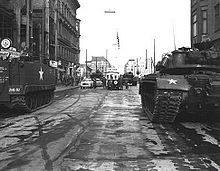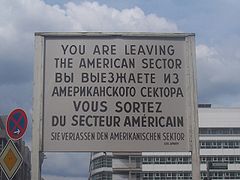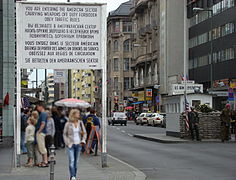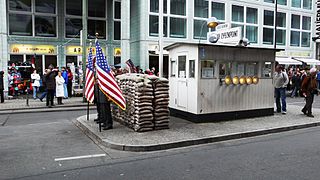checkpoint Charlie
The Checkpoint Charlie was one of the Berlin border crossings by the Berlin Wall between 1961 and 1990. He joined the Friedrichstrasse between rooms Street and Cook Street (at the metro station ) the Soviet with the US sector and the East Berlin district of Mitte with the West Berlin district of Kreuzberg . The checkpoint was set up by the Western Allies in August / September 1961 as a result of the construction of the Wall , in order to enable members of their military personnel to continue crossing the sector boundary, whereby they were registered and instructed. Controls of all other visitors to East Berlin, as everywhere on the western side, did not take place at Checkpoint Charlie.

on the East Berlin side, 1986
Allied checkpoint

On the East Berlin side, the border troops of the GDR allowed foreigners and GDR functionaries to pass through, in addition to the Allied military personnel and diplomats who enjoyed freedom of movement in Berlin , which also included employees of the Permanent Mission of the Federal Republic of Germany to the GDR . The director of the Komische Oper, Walter Felsenstein , who lives in West Berlin, also used this border crossing as an Austrian citizen.
It was one of the three Allied checkpoints used by the Americans who named it "Charlie" after the third letter in the alphabet, "C", according to the international spelling alphabet . "Checkpoint Alpha" was the name of the checkpoint at the Helmstedt-Marienborn border crossing on today's Federal Motorway 2 , which was in the British Zone , but because of the shortest motorway connection to West Berlin (168 km), it was used almost exclusively by the three Western Allies and also shared was managed. The " Checkpoint Bravo " was the American side of the Dreilinden checkpoint , which was moved in 1969 to Drewitz on today's A 115 .
The nomenclature checkpoint for checkpoint , in contrast to the eastern designation border crossing point (GÜSt) , results from the fact that from the western side the legitimacy of international law as a state border was not recognized. In this regard, after the constitutional recognition of the GDR from 1972, there was a change for the inner-German border, but not for the sector border of Berlin.
As a result of the attempt by the SED leadership to restrict allied rights of the Western powers in Berlin, Soviet and American tanks stood ready to fight on October 27, 1961 . Today we know that the commanders on both sides had orders to use their tanks if necessary. In November 1961, the United States responded to the recent Berlin crisis with Operation Stair Step . Over 200 fighter planes were relocated from the United States via Canada and the Azores to France and did not return to the United States until August 1962.
The checkpoint was the scene of spectacular escapes from what was then East Berlin. It was here that the GDR refugee Peter Fechter died , who bled to death on August 17, 1962 in front of western observers. The people's police officer Burkhard Niering took a passport control hostage in 1974 and was shot during the subsequent attempt to escape. On August 29, 1986, three GDR citizens successfully broke through the border barriers with a 7.5 t gravel truck. Hans-Peter Spitzner from Karl-Marx-Stadt was the last refugee from Checkpoint Charlie. On August 18, 1989, he crossed the border with his daughter in the trunk of an Allied vehicle.
Even before German reunification , the checkpoint was dismantled on June 22, 1990 as part of a commemoration ceremony. It can be viewed today in the Allied Museum in Berlin .
State in the 21st century


The site of the former Checkpoint Charlie is one of the most famous sights in Berlin today . On August 13, 2000, a faithful replica of the first control barrack was unveiled. The stacked sandbags are filled with concrete instead of sand. On Zimmerstraße, as in other parts of Berlin-Mitte, a double row of paving stones reminds of the course of the Berlin Wall.
In the area north of Mauerstrasse, Ronald Lauder developed the idea of an American Business Center in the 1990s . Of the planned five buildings, three were built, including the Philip Johnson House .
Replica of the sign to leave the former American sector
Wall Museum
The " Wall Museum - Museum Haus am Checkpoint Charlie " was opened on June 14, 1963 in the immediate vicinity of the Berlin Wall. It documents the history and events of the Berlin Wall , escapes and the worldwide non-violent struggle for human rights. From October 31, 2004 until the evacuation on July 5, 2005, the controversial Freedom Memorial, a white-painted wall built from original wall segments and 1067 memorial crosses for the victims of the GDR border regime stood on a leased site .
The border system and the "assistance of the protecting powers" are illustrated. In addition to photos and documentation of successful escape attempts, the means of escape are also shown: hot air balloons , escape cars, chairlifts and a mini submarine.
The operator is the Arbeitsgemeinschaft 13. August e. Founded in 1963 . V. Director of the museum is Alexandra Hildebrandt , the widow of the founder. The museum is housed in the building at Checkpoint Charlie by the architect Peter Eisenman . With 850,000 visitors in 2007, the Wall Museum was one of the most popular museums in Berlin .
Open-air gallery and black box Cold War
In the summer of 2006, an open-air exhibition was opened on the historic site of the former border crossing. Since then, visitors along Friedrichstrasse, Zimmerstrasse and Schützenstrasse have received free information on three different topics:
- The western gallery wall on Friedrichstrasse reports of numerous failed and successful escapes at the border crossing. It is shown how the border crossing was continuously perfected from 1961 to 1989 and expanded from a simple control house to a nine-lane clearance facility.
- The eastern gallery wall provides information about the events at the former border crossing and addresses the importance of Checkpoint Charlie as a symbolic place of international block confrontation . The photo series shows, among other things, how Soviet and American tanks faced each other on Friedrichstrasse in October 1961.
- On the adjoining gallery areas in Zimmerstrasse, visitors will find an overview of the most important places of remembrance and commemoration, authentic remains of the Wall, museums and documentation centers on the subject of " German division and the Berlin Wall ".
The picture gallery at Checkpoint Charlie was designed by the Berlin Forum for Past and Present e. V. on behalf of the Senate Department for Science, Research and Culture and was designed by the Berlin design office gewerk .
Since 2012, the "Black Box Cold War" exhibition area on the east side of Friedrichstrasse has been providing information about the division of Germany and Berlin. The free open-air area is surrounded by the open-air gallery and provides additional information on the historical site of the tank confrontation. The focus is on the multimedia exhibition (for a fee), where contemporary historical events are documented with the help of media stations, a cinema and original exhibits.
Development on the interface?
On the undeveloped area between Zimmerstrasse and Schützenstrasse / Mauerstrasse, on both sides of Friedrichstrasse, various tourist facilities have temporarily settled (see: Freilicht-Galerie , Panorama ). In 2016/2017, the Berlin Senate planned the complete development of the east side with a hotel for the project developer Trockland, as well as an office building with an integrated museum and remaining open space on the west side. To this end, an architectural competition was held, which the design by Berlin architects Graft / rw + for the building ensemble called Charlie Living for living, with a hotel, shops, and restaurants won. The construction costs were given at around 75 million euros.
After the site was placed under monument protection by the Berlin State Monuments Office in June 2018 , a new professional and political discussion about the appropriate use of the area developed, and criticism of the investors behind Trockland was expressed. In December 2018, the Senate decided in favor of a new plan with reduced development and a museum on the east side.
panorama
The panorama picture by Yadegar Asisi over the divided Berlin transports the visitor into everyday life with the Berlin Wall on a fictional autumn day in the 1980s. The alternative life in SO 36 in West Berlin with its punks , occupied houses, a wagon castle or a petting zoo in Kreuzberg is completely separate from life in East Berlin - and yet only a stone's throw away.
In the media
- Checkpoint Charlie can be seen in the opening scene of the Martin Ritt film The Spy Who Came Out of the Cold from 1965 (leading actor: Richard Burton ).
- The spy comedy Der Schnüffler with Dieter Hallervorden from 1983 begins with a taxi ride from East to West Berlin.
- In October 2007, Das Erste broadcast the two-part feature film Die Frau vom Checkpoint Charlie , the subject of which is Jutta Fleck's spectacular protest actions at Checkpoint Charlie in the 1980s. These actions had at times led to diplomatic resentment between the Federal Republic and the GDR.
literature
- William Durie: The United States Garrison Berlin 1945–1994, Mission Accomplished. 2014, ISBN 978-1-63068-540-9 (English).
Web links
Individual evidence
- ↑ Checkpoint Charlie . Berlin Wall Online
- ↑ On freedom of movement see Sybille Frank: Waiting for the Cultural Turn. The end of history and the silence of sociology . In: Sybille Frank, Jochen Schwenk (eds.): Turn Over. Cultural turns. Of sociology. Festschrift Fur Helmuth Berking , Campus, 2010, ISBN 9783593392776 , pp. 235–263, here p. 243.
- ↑ Challenges: A Memoir of My Life in Opera by Sarah Caldwell
- ↑ William Smyser: Between Relief and Confrontation. The reactions of the USA and the USSR to the building of the wall. In: Hans-Hermann Hertle, Konrad H. Jarausch, Christoph Kleßmann (eds.): Building and Falling the Wall. Causes - course - effects. Ch. Links, Berlin 2001, ISBN 3-86153-264-6 , p. 155 f.
- ^ TV report on the death of Peter Fechter. rbb
- ↑ The last refugee from Checkpoint Charlie. In: Picture , January 4, 2010.
- ↑ Berlin Forum for Past and Present. Retrieved October 15, 2019 .
- ↑ Homepage of Rw + with visualization of the buildings. Retrieved May 3, 2019.
- ↑ Newsletter of the State Monuments Office Berlin, August 2018. Retrieved on February 11, 2019 .
- ↑ Power word from Michael Müller - Senate plans Checkpoint Charlie again. In: Berliner Zeitung . December 4, 2018, accessed February 11, 2019 .
- ↑ 360 ° panorama of Checkpoint Charlie , accessed on May 3, 2019.
Coordinates: 52 ° 30 '26.8 " N , 13 ° 23' 25.4" E







